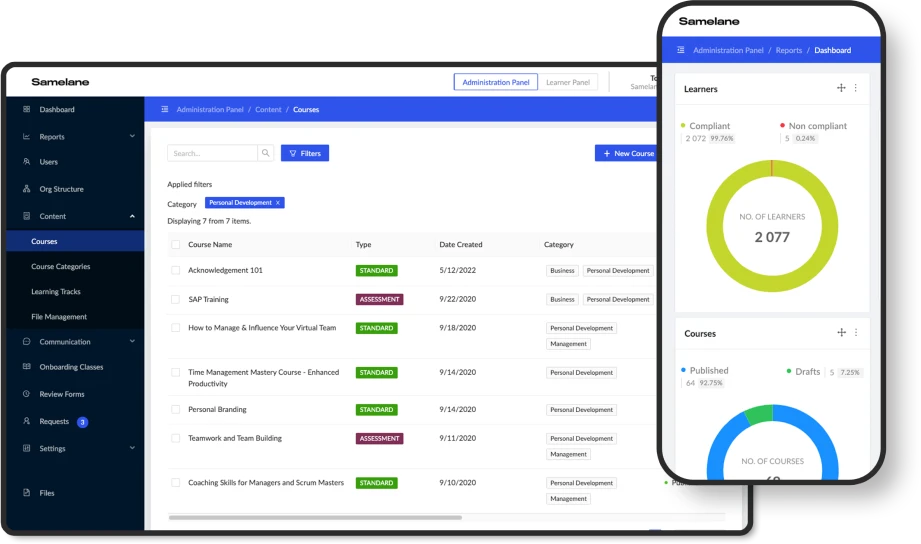Starting a new job can be an exciting yet nerve-wracking experience for new employees. A well-structured onboarding process makes new employees feel welcomed, valued, and supported in their new work environment. An effective onboarding process ensures that new hires are set up for success and productivity right from the start.
One tool that can significantly simplify the onboarding process is a Learning Management System. An LMS is a digital learning platform allowing organizations to deliver, manage, and track employee training and development. With a learning platform such as Samelane, organizations can provide new employees with on-demand access to crucial information and training materials, making the onboarding process more efficient and effective.
To simplify the onboarding process, we have compiled a comprehensive checklist divided into subcategories to be applied using an LMS. These checklists outline the crucial steps and tasks that should be completed during onboarding to ensure a smooth transition for new employees.

Pre-Onboarding Checklist
Before a new employee’s first day, it’s essential to ensure that all necessary preparations have been made. Hence, a pre-onboarding checklist will be of much help. It is a list of tasks and activities an organization should complete before a new employee’s first day on the job. Completing these tasks before the new employee’s first day can help ensure that the onboarding process runs smoothly and that the new employee is set up for success from the start. Some items that might be included in a pre-onboarding checklist template are:
- Sending a welcome email to the new employee, providing an introduction to the company and their first-day schedule.
- Setting up the employee’s workstation and providing all necessary equipment, such as a computer, phone, and software.
- Creating and sending login credentials for the company’s systems and software.
- Assigning a buddy or mentor to the new employee to provide guidance and support during onboarding.
- Providing any necessary paperwork or forms for the new employee to complete before their first day.
- Conducting a background check or other necessary screenings.
- Reviewing the job description and expectations with the hiring manager.
- Coordinating with HR to ensure all necessary paperwork, such as tax forms and benefits enrollment, is completed before the employee’s first day.
First-Day Checklist
The first day is critical to setting the tone for the employee’s experience with the company. So, this first-day checklist comes in handy on a new employee’s first day on the job. The purpose of this checklist is to provide the new employee with a warm welcome, a clear understanding of their role and responsibilities, and the necessary resources and tools to begin their job successfully. Completing these tasks on the new employee’s first day can help create a positive first impression and set the tone for a successful onboarding process. In addition, by providing a clear understanding of the organization’s goals, policies, and expectations and ensuring that the employee has the necessary resources and tools, the organization can help the new employee feel welcomed, supported, and ready to succeed new role. Items that might be included in a first-day onboarding template are as follows:
- Welcoming new employee and introducing them to their team and any relevant staff members.
- Providing a tour of the workplace, including the location of the employee’s workstation, restrooms, and break rooms.
- Reviewing the company’s mission, values, and culture to help the employee understand the organization’s goals and priorities.
- Providing an overview of the company’s policies and procedures, including any relevant safety protocols.
- Providing the employee with the necessary equipment, such as a computer, phone, or security badge, and ensuring all software and systems are set up correctly.
- Assigning initial training courses or tasks through the company’s learning management system.
- Scheduling time for the employee to meet with their supervisor to review their job description, expectations, and goals.
First-Week Checklist
During the first week, the new employee should be given a clear understanding of their role and expectations. On this checklist you will find items that business should take care of during the first week of a new employee’s onboarding process. It’s purpose is to help the new employee become more familiar with their role, their team, and the organization as a whole. Here are some of the aspects that might be included in a first-week checklist:
- Reviewing the employee’s job description and expectations to ensure that the employee has a clear understanding of their role and responsibilities.
- Assigning additional training courses or tasks on the company’s learning management system to help the employee gain knowledge and skills relevant to their role.
- Providing opportunities for the employee to meet with other staff members, learn about other departments, or attend relevant meetings.
- Setting up regular check-ins with the employee’s supervisor or mentor to answer any questions or concerns and provide guidance and support.
- Providing an overview of the company’s products or services to help the employee understand the organization’s goals and priorities.
- Explaining company policies, such as time off, benefits, dress code, or other expectations.
- Introducing the employee to tools or software that they will need to use to perform their job, and providing additional support or training as needed.
First-Month Checklist
A first-month checklist includes tasks and activities that an organization should complete during the first month of a new employee’s onboarding process. The purpose of this checklist is to ensure that the new employee has fully integrated into their role, their team, and the organization as a whole. The following are some of the items that might be included in a First-Month Checklist:
- Scheduling a meeting with the employee’s supervisor to review their progress, provide feedback, and set goals for the future.
- Assigning further training courses or tasks on the company’s learning management system to help the employee continue to develop their skills and knowledge.
- Providing any necessary feedback or coaching to support the employee’s success.
- Encouraging the employee to provide feedback on their onboarding experience and make suggestions for improvement.
- Setting up regular performance reviews or check-ins to help the employee stay on track with their goals and responsibilities.
- Providing the employee with opportunities to contribute to the organization’s goals, such as participating in team projects or taking on additional responsibilities.
Ensure employee onboarding completeness with Samelane
By following this comprehensive onboarding checklist for new employees facilitated by Samelane LMS, company can ensure that new hires are set up for success right from the start. This way, organization can enhance employee engagement, reduce turnover, and drive productivity by providing the necessary resources and support. With a streamlined onboarding process, new employees can feel welcomed, valued, and supported, allowing them to hit the ground running and positively impact the organization.











